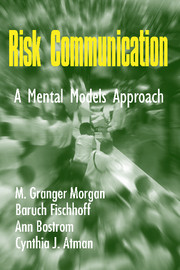Book contents
- Frontmatter
- Contents
- Preface
- Risk Communication
- 1 INTRODUCTION
- 2 OUR MENTAL MODELS APPROACH
- 3 CREATING AN EXPERT MODEL OF THE RISK
- 4 MENTAL MODELS INTERVIEWS
- 5 CONFIRMATORY QUESTIONNAIRES
- 6 DEVELOPMENT AND EVALUATION OF COMMUNICATIONS
- 7 CASE STUDIES: APPLICATIONS TO ENVIRONMENTAL RISKS
- 8 A MENTAL MODELS APPROACH TO HIV/AIDS
- 9 SOME CONCLUDING THOUGHTS
- Appendix A Brochure on global warming and climate change
- Appendix B Brochure on fields from electric power
- Appendix C Risk communication materials on HIV/AIDS
- Appendix D Sample transcripts of mental model interviews
- Index
1 - INTRODUCTION
Published online by Cambridge University Press: 05 June 2012
- Frontmatter
- Contents
- Preface
- Risk Communication
- 1 INTRODUCTION
- 2 OUR MENTAL MODELS APPROACH
- 3 CREATING AN EXPERT MODEL OF THE RISK
- 4 MENTAL MODELS INTERVIEWS
- 5 CONFIRMATORY QUESTIONNAIRES
- 6 DEVELOPMENT AND EVALUATION OF COMMUNICATIONS
- 7 CASE STUDIES: APPLICATIONS TO ENVIRONMENTAL RISKS
- 8 A MENTAL MODELS APPROACH TO HIV/AIDS
- 9 SOME CONCLUDING THOUGHTS
- Appendix A Brochure on global warming and climate change
- Appendix B Brochure on fields from electric power
- Appendix C Risk communication materials on HIV/AIDS
- Appendix D Sample transcripts of mental model interviews
- Index
Summary
The Context of Risk Communication
There are many different kinds of risk. In one study, we asked a group of citizens to “make a list, in whatever order they come to mind, of the risks that most concern you now” (Fischer et al., 1991). The most frequent nominations were everyday threats to life and limb, such as accidents, disease, and crime. Also listed were economic risks, such as the possibility of losing a job or making a bad investment. Some people listed personal concerns, such as their love life going sour or their child flunking out of school. The risk of eternal damnation was also mentioned. Only 10% of the risks cited were from environmental hazards, natural hazards (e.g., floods and earthquakes), or technology. Clearly “risk” is a very broad topic. In a subsequent study, when we asked people to focus specifically on “health, safety, and environmental risks,” they readily provided many such hazards. However, as shown in Table 1.1, even then, everyday risks, such as drugs, auto accidents, and conventional pollutants, dramatically outranked more exotic ones.
Whereas professional risk experts devote many hours to considering rare and unusual hazards, most people do not share this preoccupation. With jobs, family, friends, and the other demands of daily living, their lives are filled with more immediate concerns. Of course, given that modern life is awash in risks, people must deal with them in one way or another.
- Type
- Chapter
- Information
- Risk CommunicationA Mental Models Approach, pp. 1 - 18Publisher: Cambridge University PressPrint publication year: 2001
- 1
- Cited by



